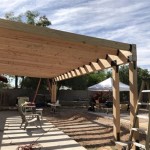How to Build a Screen Porch on Your Patio
A screened porch offers a wonderful way to enjoy the outdoors without the hassles of insects and harsh weather. Adding a screened porch to your existing patio can transform your home, providing a comfortable and bug-free space for relaxing, dining, or entertaining. This article outlines the essential steps to building a screen porch on your patio, ensuring a safe and successful project.
1. Planning and Design
Before you start building, meticulous planning is crucial. This phase involves defining your desired porch size, location, and features. Consider the following:
- Porch Size and Shape: Determine the ideal size and shape of your porch. Account for available space, existing patio dimensions, and desired functionality.
- Location: Choose the perfect spot on your patio, taking into consideration sunlight exposure, views, and accessibility.
- Features: Decide on desired features like a ceiling fan, lighting, and built-in seating. Plan for electrical outlets and any plumbing connections if necessary.
- Building Codes and Permits: Consult local building codes and obtain necessary permits for the construction project. This step ensures compliance with regulations and safety standards.
Sketch a simple blueprint of your intended porch. Include dimensions, materials, and key features for clarity. This plan serves as a visual guide throughout the construction process.
2. Foundation and Framing
The foundation and framing are the skeletal structure of your screened porch. A robust foundation is vital for stability and longevity. Choose a suitable foundation type based on your soil conditions and load capacity.
- Concrete Slab: A concrete slab foundation is a durable and solid option. It can be poured directly onto a compacted gravel base.
- Pier and Beam: This foundation consists of piers supporting a framework of beams, offering flexibility and adaptation to uneven terrain.
- Wooden Deck: Building upon an existing wooden deck can be a time-saving option, but it requires careful assessment of the deck's structural integrity.
Once the foundation is complete, you can begin framing the porch. Use pressure-treated lumber for longevity and resistance to moisture. Follow your blueprint to build a sturdy frame that aligns with your chosen design.
3. Roof Construction
The roof of your screened porch provides protection from the elements. Choose roofing materials that suit your aesthetic preferences and budget. Consider:
- Shingles: Asphalt shingles are a cost-effective option with a wide range of colors and styles.
- Metal Roofing: Durable and low-maintenance, metal roofing can last for decades. It offers excellent weather resistance and energy efficiency.
- Other Options: Explore alternative materials like cedar shakes or tile depending on your design and budget.
Ensure proper ventilation for the roof to prevent moisture buildup, especially if using shingles or other materials susceptible to water damage.
4. Screen Installation
Installing screens is the defining element of a screened porch. Today, a variety of screen materials are available, each with its own advantages.
- Fiberglass Screens: Classic and affordable, fiberglass screens provide good visibility and air circulation.
- Aluminum Screens: Durable and weather-resistant, aluminum screens are ideal for areas with high wind or frequent storms.
- Pet-Resistant Screens: These screens are fortified with stronger materials to withstand the wear and tear of pets.
- Solar Screens: Providing excellent sun protection, solar screens reduce heat gain and glare while preserving light.
Install the screens using a screen door staple gun or nail gun. Ensure a snug fit to prevent insects from entering. For larger areas, consider using screen panels or rolled screen material.
5. Finishing Touches
Adding the finishing touches enhances the functionality and aesthetics of your screened porch. These steps include:
- Flooring: Choose a flooring material that complements your patio and porch design. Options include concrete, tile, or wood decking.
- Lighting: Install appropriate lighting to create ambiance and ensure safety after dark. Consider pendant lights, recessed lighting, or string lights.
- Furniture: Furnish your screened porch with comfortable seating, tables, and other accessories to make it your own personal oasis.
- Plants: Add greenery to enhance the natural feel of your screened porch. Potted plants or climbing vines create a lush and inviting space.
Regular maintenance is essential for preserving your screened porch. This includes cleaning screens, inspecting the structure, and addressing any minor repairs promptly.

Do It Yourself Diy Screened In Porch The Original Screen Tight System

How To Build A Screened In Porch On Concrete Extreme

Create A Three Season Room With Diy Screened In Porch

45 Awesome Diy Screened In Porch Ideas Designs On A Budget 2024 Screen House Design

Create A Three Season Room With Diy Screened In Porch

How To Convert A Flagstone Patio Into Screened In Porch

Diy Screened In Porch Makeover Blessed Beyond Crazy

Building Our Screened In Back Porch

Diy Screened Porch Newlywoodwards

Do It Yourself Diy Screened In Porch The Original Screen Tight System
Related Posts








